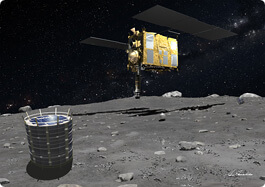In December of this year, Japan will launch the Yabusa 2 spacecraft, which will send a lander to a medium-sized asteroid and return soil samples from it

Following Japan's success in returning to Israel soil samples from an asteroid called Itokawa using the Yaabusa spacecraft, the Japanese space agency decided to launch a spacecraft to another asteroid, the Yaabusa 2 spacecraft. The asteroid's designation is JU3 1993. A name has not yet been given to it. The diameter of the asteroid is 900 meters, it rotates around its axis once every 7.6 hours, its distance from the sun is 1.9 astronomical units and it orbits it once every 1.3 years. The asteroid is of type C.
The spacecraft will be launched in December 2014, reach it in mid-2018, leave it in December 2019 and land on Earth in 2020. Upon the arrival of the spacecraft to the asteroid, it will enter orbit around it and circle it for 18 months. During this period, she will collect soil samples from him and return to Israel. The weight of the spacecraft is 585 kg and it has two sun shelves. The spacecraft's instrumentation includes a camera, a spectrometer and a device for topographical measurements and a one meter long arm for collecting soil samples. In addition, the spacecraft is equipped with a tiny surface vehicle, called Minerva, and a tiny German lander called MASCAT (Surface Scout Mobile Asteroid). The lander will measure the asteroid's magnetic field, surface temperature, rock composition and ground photography during the descent to the surface.
The researchers intend to reveal some of the secrets of the solar system in the first stages of its formation, including building blocks of life such as amino acids. This asteroid can serve as a bridge for understanding what happens between the beginning of the formation of the solar system and the beginning of life on Earth.
The first sample collection from the ground will be taken when the spacecraft will approach the ground at a low speed and will stay on the ground for a very short time and with the help of the small arm will collect the soil sample. The other two sampling blocks will focus on rocks identified as containing hydrates, water-rich minerals and organic matter. At each of these gatherings, the spaceship will launch a small projectile towards the ground that will throw up ground splashes, these will enter an opening in the spaceship that is 1.1 cm long and will be collected in a storage tank. The total weight of the samples is between one and several grams.
The projectiles are launched when the spacecraft is 100 meters from the ground and the speed of the projectiles is two kilometers per second. The researchers hope that where the projectiles hit, craters will be formed that will reveal part of the surface of the earth and thus it will be possible to learn about its internal structure and the history of asteroids of this type.
Sources
1. Stephen C. – “Japan's next asteroid probe approved for development"29.1.2012
2. Stephen C. – “Japan prepares for asteroid sample return” 26.3.2013
3. 'Space cannon ready: Japan to shoot asteroid for samples in 2014 mission” 24.10.2013

3 תגובות
For fun, I take a submarine straight into the ocean of methane, who knows, maybe I'll see something interesting there 🙂
A. From the Ministry of Space Tourism
We need both this and that.. As for the moons of Jupiter, they are indeed working on spacecraft that will land there. Since you are involved in tourism, maybe you will prepare vacation packages for Titan. Think about it.
It is not better to concentrate efforts and send a probe over the moons of Jupiter (Europa Callisto for example) or Saturn (Titan)